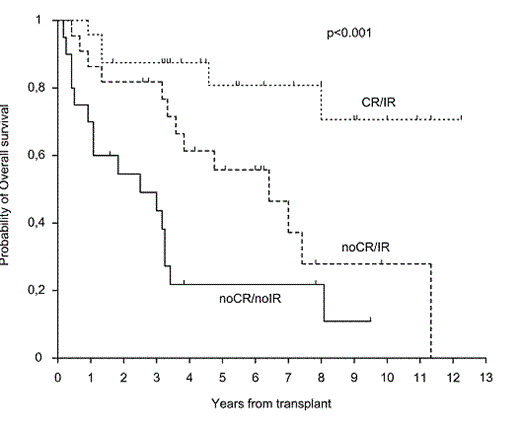Abstract
Minimal residual disease (MRD) by multiparameter flow-cytometry recently showed a promising role in predicting outcomes in patients with multiple myeloma. However, data on immunophenotypic response (IR) after allografting are lacking.
To evaluate the impact of IR and compare it to conventional complete remission (CR) following allografting in myeloma patients.
Sixty-six consecutive patients, median age 54 years (35-66), who underwent an allograft between January 2000 and December 2011 with a follow-up of at least 3 months were included. Disease response was evaluated by serum and urine electrophoresis, and bone marrow aspirate at baseline, 3, 6, 12, 18, 24 months after transplant and yearly thereafter. Skeletal survey or MRI were performed yearly or as clinically indicated (overt relapse or complaints of bone pain). Bone marrow aspirates had to contain at least 13000 cells/µL for flow-cytometry studies and IR was defined as absence of monoclonal plasma-cells detected by 4 or 6-colour staining with the following antibodies: CD38, CD138, CD56, CD19, CD45, cyKappa, cyLambda. CR was defined according to standard criteria (Durie et al, Leukemia 2006; 20:1467-73).
Conditioning regimen was non-myeloablative 2Gy TBI-based in 55 patients, reduced intensity (fludarabine-melphalan-based) in 10 and myeloablative in 1 patient. Post-grafting immunosuppression consisted of cyclosporine with mycophenolate mofetil or methotrexate. Donors were HLA identical siblings in 58 patients and unrelated in 8. Only 1 patient received bone marrow as source of stem cells. Thirty-five/66 (53%) received the allograft as part of the first line treatment, whereas the remaining 31/66, (47%) were transplanted at relapse. At the time of transplant, 5/66 were both in IR and CR, 16 were only in IR and 4 patients were only in clinical CR. All 21 patients in IR at the time of transplant maintained it, while 26/45 (58%) entered IR after the allograft. Among patients surviving at least 3 months, overall treatment related mortality was 10.6% at 3 years. After a median follow-up of 69 months (range 19-147), the incidence of acute and chronic graft-versus-host disease was 45.6% and 49.3% without significant difference between responsive and non-responsive patients. At follow-up, overall, 24 patients achieved CR and IR (CR/IR group), 21 achieved IR but not CR because of persistence of urine/serum M-component (noCR/IR group), and 21 did not achieve either CR or IR (noCR/noIR group). Interestingly, none achieved CR without IR. Median overall survival (OS) and event-free survival (EFS) in patients who achieved IR were 96 and 55 months versus 36 and 7 months in those who did not (p<0.001). Median OS and EFS were not reached and 59 months in the CR/IR group, 77 and 15 months in the noCR/IR, and 30 and 5 months in the noCR/noIR respectively (p<0.001 for both EFS and OS-fig.1). In univariate analysis, being in the CR/IR group was the only significant predictor for prolonged OS and EFS (p<0.001). Of note, cumulative incidence of extra-medullary disease at first relapse after the allograft was 4% in the CR/IR, 32% in the noCR/IR and 15% in the noCR/noIR groups respectively (p<0.001). Receiving the allograft as first line therapy or later during the disease course did not significantly impact on OS and EFS.
The achievement of IR confers a favorable impact on OS and EFS after allografting. A higher incidence of extra-medullary in the noCR/IR group (some 30% of our patient cohort) may suggest that myeloma cells escape immune control outside the bone marrow. In this group, imaging studies such as positron emission tomography may clinically be indicated during follow-up to detect early relapse.
No relevant conflicts of interest to declare.
Author notes
Asterisk with author names denotes non-ASH members.


